One of my favorite ways to capture blueberry’s flavor and nutrients at the height of summer is with a blueberry vinaigrette. It’s a creation that emerged from my garden one summer and quickly became a kitchen staple beloved by friends and family.
My son’s favorite fruit is blueberries. Since he was little he would just eat as many as he could get his hands on. He ate them so much that my husband wrote a song for him about blueberries:
Blueberries, oh I like blueberries
Blueberries, gonna eat them all the time
Eat them for my breakfast, eat them for my lunch
Eat them for my dinner cause I like them so much
Talkin’ about blueberries, oh I like blueberries, gonna eat them all the time!
This is one reason you’ll find recipes with blueberries in my book, The Herbal Kitchen, including this one.
Along with the recipe, I’m sharing an idea for how to use blueberry vinaigrette in a refreshing summer drink: the shrub!
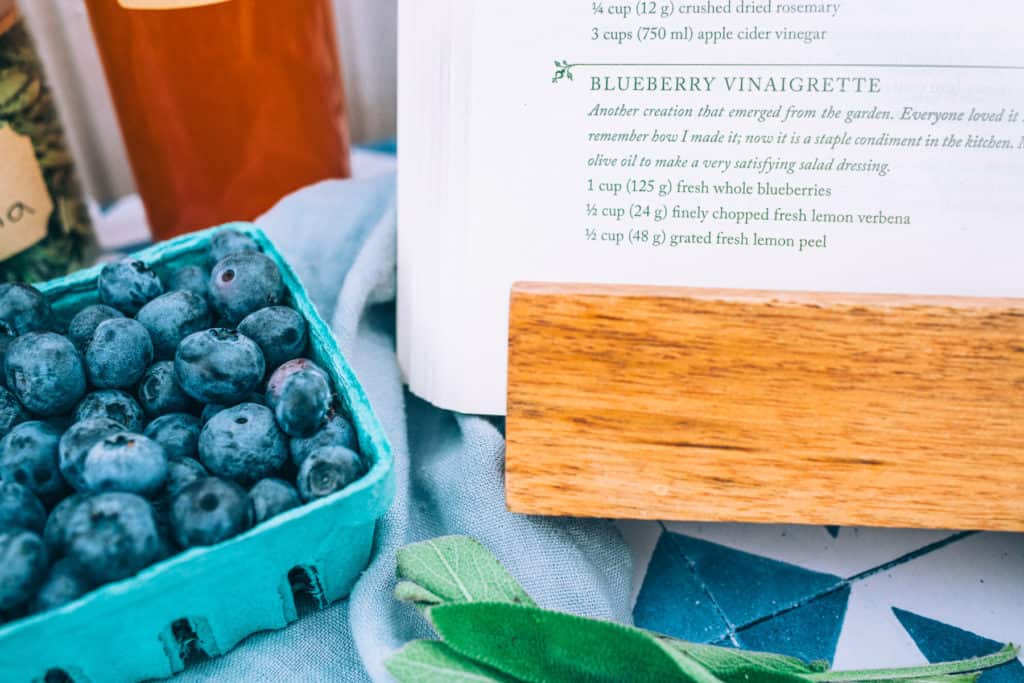
Abundance, Scarcity, and Blueberry Vinaigrette
If you’ve ever tasted blueberries in season, whether plucked from your own garden or purchased from a local farmer, you know that a wintertime blueberry from the store simply can’t compare.
We live alongside the illusion of abundance year round, but nature speaks the languages of abundance and scarcity in turn, and there’s no fooling the taste buds when it comes to local, peak, in-season fruit.
Fruit vinegars are one way humans have found to adapt to nature’s extremes. If you have an abundance of blueberries, vinegar is a wonderful medium for extracting the flavors, vitamins, and minerals so the fruit can continue to nourish us when berries become scarce.
Steeping fruit in vinegar is easier than canning, and doesn’t require the jaw-dropping amounts of sugar needed to stabilize jams and jellies. While drying and freezing are relatively simple options, this blueberry vinaigrette is just as easy and can be used beyond the bounds of smoothies and oatmeal toppers.
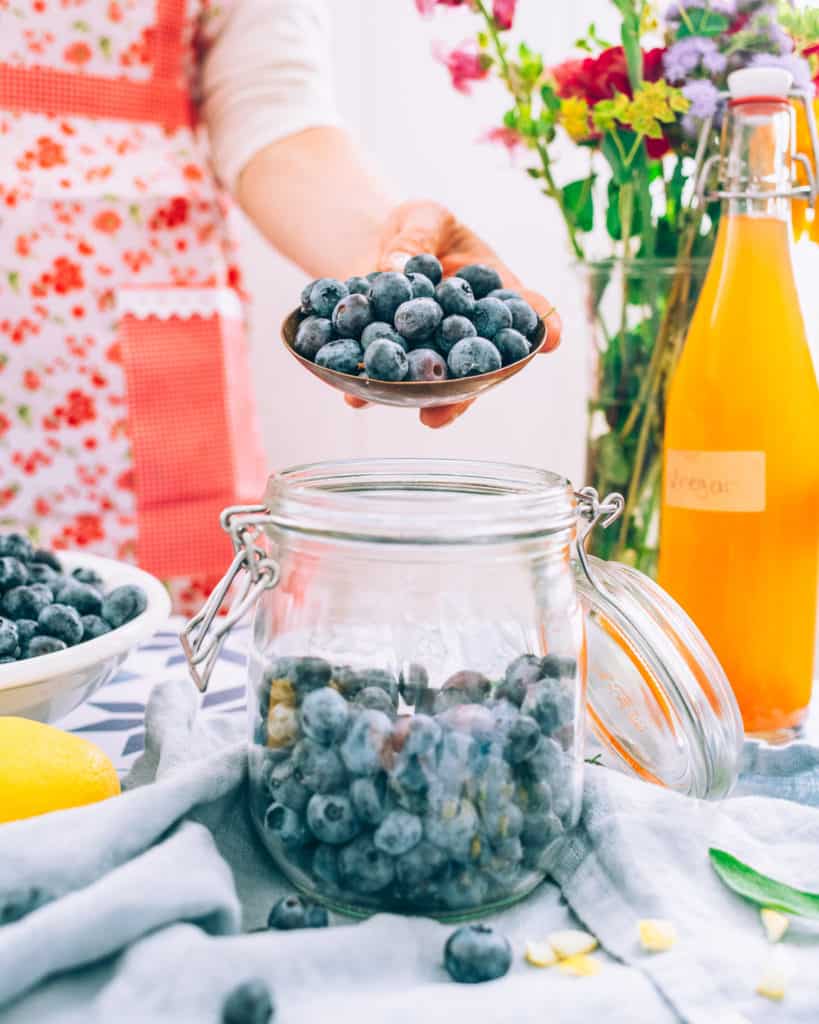
Featured Ingredients
The ingredients in this blueberry vinaigrette are tasty – and a win for your body, too.
Blueberries
Berries, including blueberries, are believed to be one of the richest sources of antioxidants in common fruits. This is largely thanks to anthocyanins, the pigments that give them color. In addition, blueberries are rich in vitamins C, K, and the mineral manganese. Studies have found that people who eat blueberries regularly tend to have healthier circulatory systems and higher levels of brain function.
Lemon Verbena (Aloysia citrodora)
Over the years, again and again, I have seen lemon verbena make people happy. Simply smelling the plant can invite calm and a mild euphoria. It has a pleasant, tangy flavor perfect for summer drinks, and is high in antioxidants. Research suggests that its antioxidant properties may help keep inflammation in check, and improve muscle recovery after working out.
There is nothing like taking folks on an herb walk and introducing a small group of people to lemon verbena. Stand back and just listen to the cooing, ooh and ahhing! It is really a treat to discover this plant for the first time and then to smell it forever more whenever the leaves are peak in your garden. I sniff on my lemon verbena several times every single day in the summer. And I still ooh and ahh!
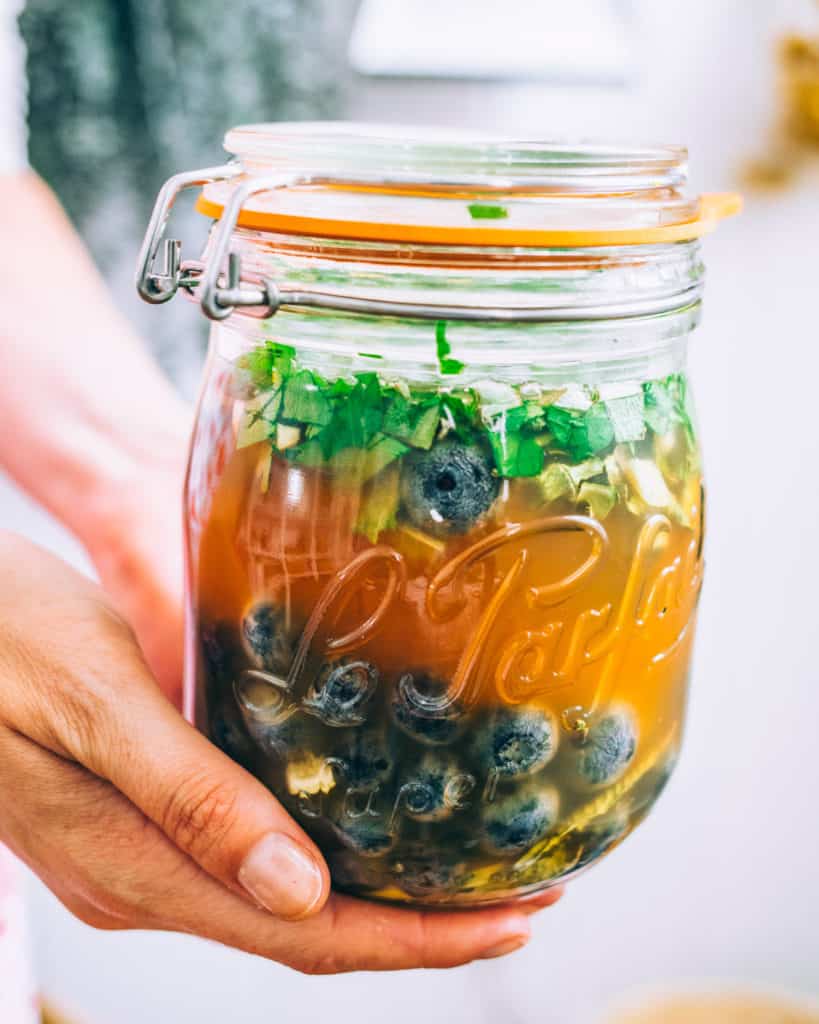
Lemon Peel
Lemon peel is high in vitamin C – gram for gram it boasts more than three times the vitamin C content of lemon juice. In addition, it contains small amounts of minerals including calcium, magnesium, and potassium.
Apple Cider Vinegar (ACV)
Organic, raw apple cider vinegar is a great base for many fruit vinegars, for both taste and health reasons. Its benefits to the body include its alkalinizing effect, as well as its potential to improve insulin function and lower blood sugar levels after meals.
Additionally, raw apple cider vinegar hasn’t been heated, so it contains beneficial enzymes. And the higher production standard means it’s of an all-around higher quality than more processed vinegars.
Watch out for apple cider “flavored” vinegars. These are essentially an imitation ACV made from white vinegar with caramel coloring.
Blueberry Vinaigrette Recipe
Ingredients
- 1/2 cup finely chopped fresh lemon verbena or 1/4 cup dried
- 1 tbsp finely chopped fresh sage
- 1 tbsp finely chopped fresh parsley
- 1 cup fresh, whole blueberries
- 1/2 cup grated or chopped fresh lemon peel
- 3 cups apple cider vinegar
- 1 cup honey
Instructions
- Prep the ingredients: chop fresh herbs as finely as possible.
- Fill a glass jar with the blueberries, grated lemon, and finely chopped herbs.
- Pour vinegar over the ingredients by at least a couple of inches.
- Vinegar corrodes not only metal, but it also eats wax and parchment paper. Many vinegar recipes call for putting wax paper over the jar before putting on the metal lid, but it doesn’t take long to realize that the vinegar eats the paper also, leaving behind black streaks. This is one place where it is just best to use a plastic or cork lid.
- Let the fruit and herbs infuse for one month, storing the jar in a cool, dark place.
- During that month, shake the jar occasionally and check to see if you need to add more vinegar, as some of it may have been soaked up by the plant material. If the fruit or herbs are sticking out above the vinegar, add more vinegar.
- To decant: Place a funnel into the opening of a clean, sterilized jar, and lay muslin over the top of the funnel.
- Pour the vinegar through the muslin, being careful not to let the contents fall out of the side of the cloth.
- Let all the vinegar strain through the funnel into the clean jar, resisting the temptation to squeeze the fresh ingredients in the muslin. Doing so will squeeze water into your vinegar, clouding the finished product and shortening its shelf life.
- Discard the strained ingredients into the compost. The liquid left behind is your herbal vinegar.
- Add the honey and mix well.
- To store: Use a cork or plastic lid; label and date your container, and store it in a dark cabinet away from light and heat. Under these conditions, your blueberry vinaigrette should last about a year. If it turns black, has floating chunks, or develops mold or a funny smell, throw it away.
Notes
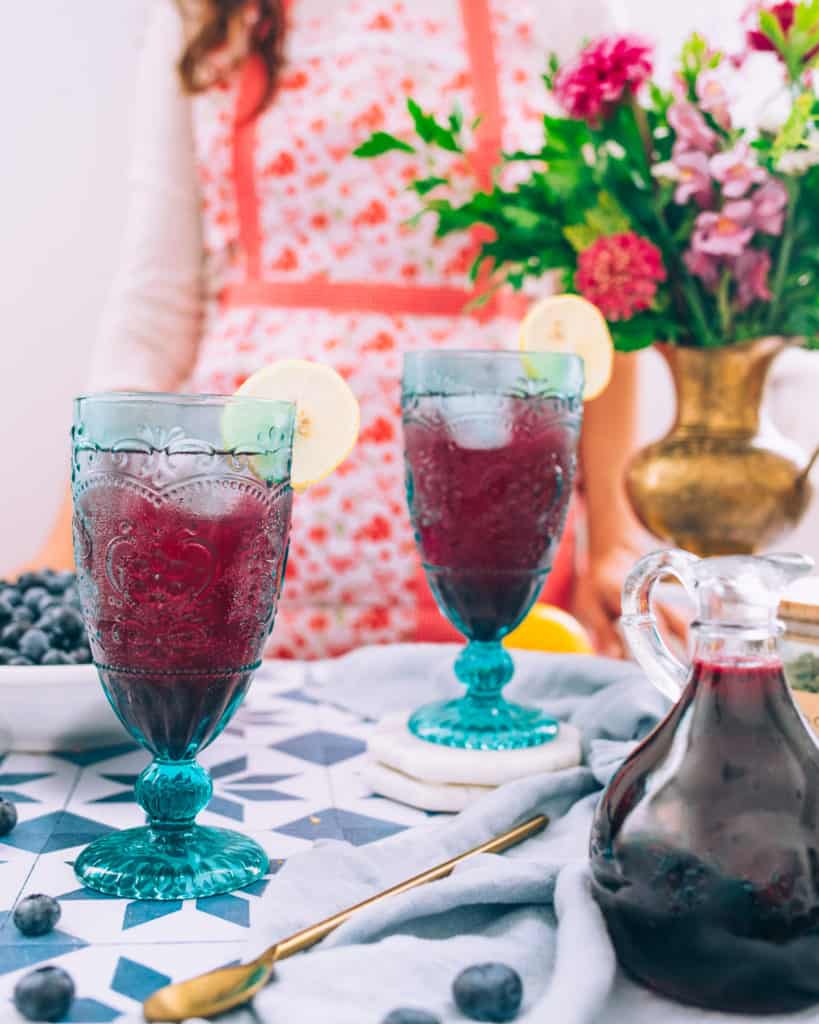
Transforming Your Blueberry-Infused Vinaigrette into a Shrub
Sweetened fruit vinegars – known as shrubs or drinking vinegars – were a popular way to preserve fruit in the 18th and 19th centuries. Shrubs can be added to a cocktail, mixed with tea or sparkling water to make a mocktail, or even taken straight in small amounts.
While my blueberry vinaigrette contains some honey, a traditional shrub would be steeped in equal parts vinegar and sweetener. We can achieve a similar flavor profile by adding a bit more sweetness to the mix.
To transform your finished fruit vinegar into a refreshing summer shrub, add ½ part raw honey to 1 part blueberry vinaigrette. Mix, pour over ice, top with sparkling water, and garnish with fresh herbs or citrus peel.
If you haven’t tried making drinks with shrubs before, you are in for a surprise, they are SO yummy!
Alternatively, if you have a favorite herbal drink on hand – like this honey-sweetened ginger ale – or Basil Ginger Limeade. Try mixing 1 part blueberry-infused vinaigrette with 2 parts herbal drink. Serve over ice and garnish with lemon or lime.
Like this recipe and want more??
You don’t have to be an herbalist or an incredible cook to unlock the healing potential of your food. Discover how common kitchen herbs can help you harness the power of natural, preventative health care in my online course, My Herbal Kitchen.
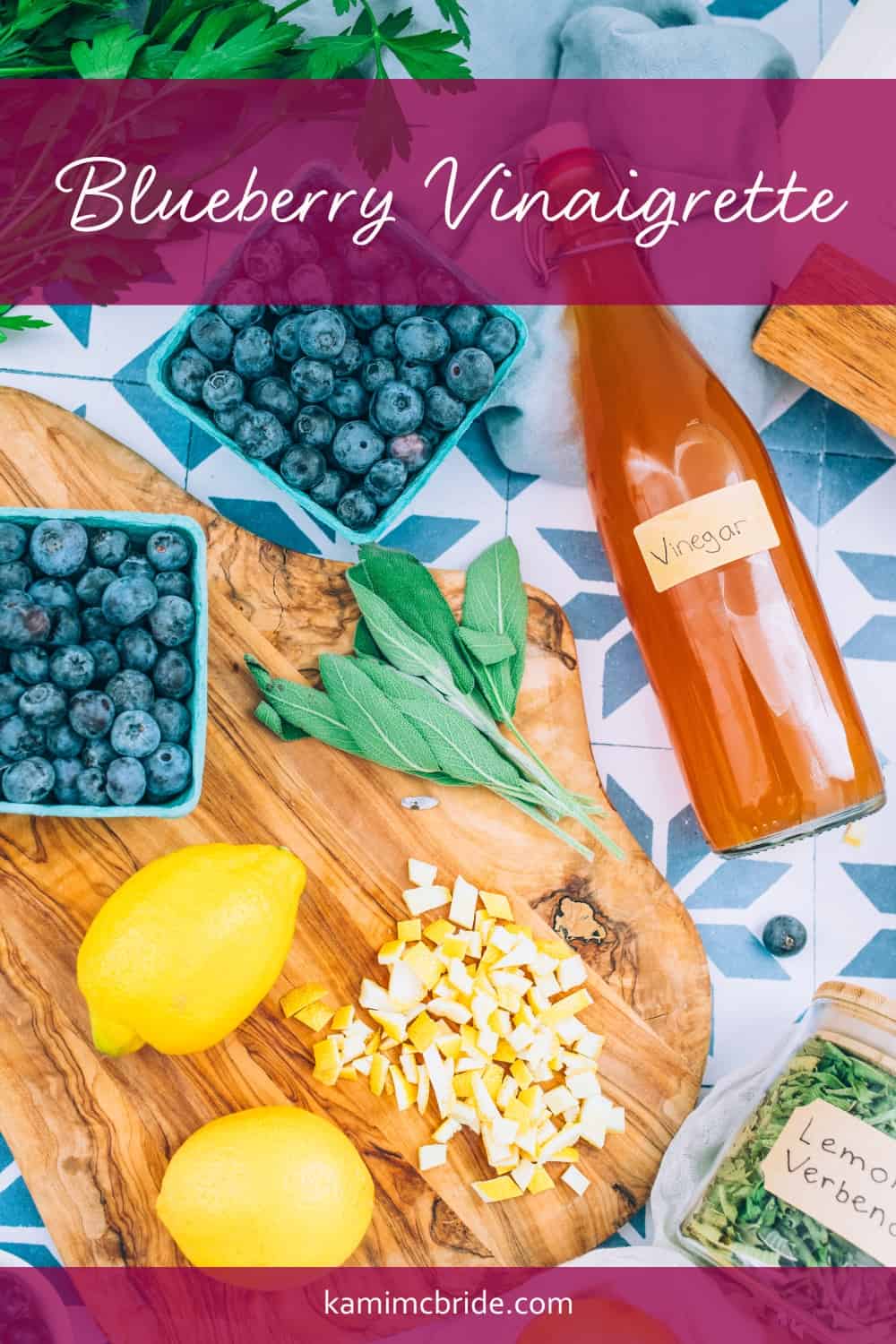

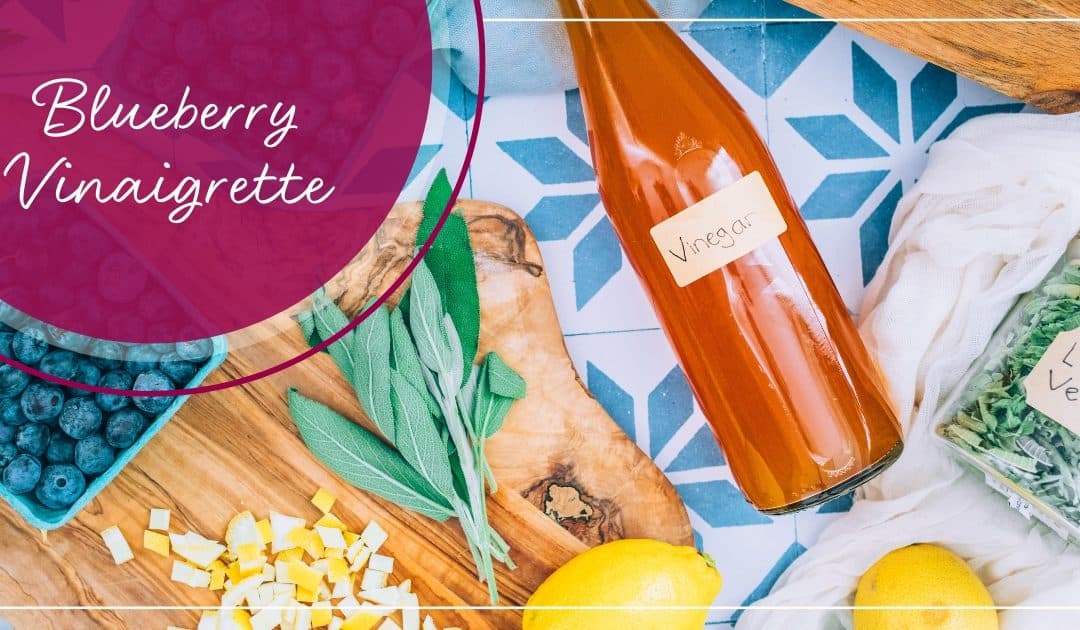




Oops, saw that dried verbena was ok in recipe. Added dried lemon peel too…hope that’s ok.
All of my recipes are meant to be played with, go ahead and experiment!